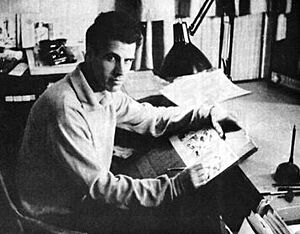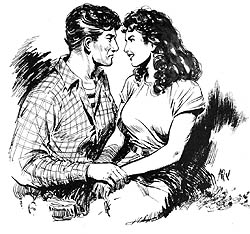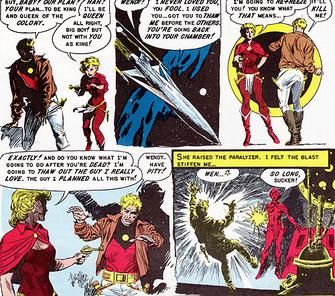Al Williamson facts for kids
Quick facts for kids Al Williamson |
|
|---|---|
 |
|
| Born | Alfonso Williamson March 21, 1931 New York City, U.S. |
| Died | June 12, 2010 (aged 79) Upstate New York, U.S. |
| Area(s) | Penciller, Inker |
| Awards | Eisner Award Best Inker (1991, 1997) Eisner Award Hall of Fame (2000) Inkwell Awards Joe Sinnott Hall of Fame (2010) |
Alfonso Williamson (born March 21, 1931 – died June 12, 2010) was an American cartoonist and comic book artist. He was known for his amazing drawings in adventure, Western, science fiction, and fantasy stories.
Al Williamson was born in New York City. He spent part of his childhood in Bogotá, Colombia. When he was 12, he moved back to the United States. As a young person, Williamson loved comic strips, especially Flash Gordon by Alex Raymond. He took art classes and met other future cartoonists like Wally Wood and Roy Krenkel. Soon, he started working in the comics world.
Some of his most famous works include his science-fiction and heroic-fantasy art for EC Comics in the 1950s. He worked on comics like Weird Science and Weird Fantasy. In the 1960s, he became well-known for drawing Flash Gordon comic books. He also helped create the black-and-white horror comics magazines Creepy and Eerie.
During the 1970s, Williamson mostly worked on his own comic strip, Secret Agent X-9. Later, he became famous for drawing comic book versions of the Star Wars movies and newspaper strips. From the mid-1980s to 2003, he mostly worked as an inker. This means he added the final ink lines to other artists' pencil drawings. He inked many Marvel Comics superhero titles, including comics for Daredevil, Spider-Man, and Spider-Girl.
Williamson often worked with a group of artist friends. This group included Frank Frazetta, Roy Krenkel, Angelo Torres, and George Woodbridge. They were playfully called the "Fleagle Gang." Al Williamson inspired many younger artists and helped new talents like Bernie Wrightson and Michael Kaluta start their careers. He won several awards for his work. He retired in his seventies and passed away in 2010. In 2000, he was added to the Will Eisner Comic Book Hall of Fame.
Contents
Al Williamson's Life Story
Growing Up and Starting Out
Alfonso Williamson was born in Manhattan, New York City. His father was from Colombia and his mother was American. When Al was two, his family moved to Bogotá, Colombia. He learned to speak both English and Spanish there. Williamson said that comic books helped him learn to read in both languages.
When he was nine, he became interested in comic strips. He especially loved Alex Raymond's Flash Gordon after seeing the Flash Gordon Conquers the Universe movie. In Bogotá, he met another cartoonist, Adolfo Buylla, who gave him art tips. In 1943, at age 12, Williamson moved with his mother to San Francisco, California, and later to New York.
In the mid-1940s, Williamson kept drawing. He took art classes from Tarzan cartoonist Burne Hogarth. There, he met Wally Wood and Roy Krenkel, who also became famous cartoonists. Roy Krenkel showed him the work of great illustrators who influenced adventure comic artists. Williamson also visited comic book publishers and met artists like George Evans and Bob Lubbers.
Williamson's first professional art job might have been helping Burne Hogarth draw some Tarzan Sunday pages in 1948. He also drew small pictures for a story in Famous Funnies and a Boy Scouts story in New Heroic Comics. He also worked on a crime story called "The Last Three Dimes." Williamson said that Hogarth wanted him to draw Tarzan exactly like him, but he found it hard. Instead, he suggested another artist, John Celardo. Later, Williamson did help Hogarth by tightening up his layouts and drawing pages.
Williamson met his biggest art hero, Alex Raymond, when he was 18. Raymond spent about two hours talking with him.
Working in the 1950s
From 1949 to 1951, Williamson drew science-fiction and Western stories for different publishers. He often worked with Frank Frazetta, who would ink his drawings, and Roy Krenkel, who drew backgrounds.
In 1952, Williamson started working for EC Comics. This company was known for its high-quality artists. At EC, Williamson often teamed up with Frank Frazetta, Roy Krenkel, and Angelo Torres. This group of friends was known as the "Fleagle Gang." Williamson mostly drew for EC's science-fiction comics like Weird Science and Weird Fantasy. He drew both new stories and adaptations of stories by famous writers like Ray Bradbury. His art also appeared in EC's horror and crime comics.
Williamson worked at EC until 1956 when most of their comics were canceled. His EC art is praised for being very detailed and exciting. His last EC story was "A Question of Time" in Shock Illustrated. In 1956, Williamson met writer Archie Goodwin, who became a good friend and frequent collaborator. Williamson even helped Goodwin get his start in comics.
From 1955 to 1957, Williamson drew over 400 pages for Atlas Comics, which later became Marvel Comics. He drew many types of stories, but mostly Westerns. He continued to work with Torres and Krenkel, as well as Gray Morrow and George Woodbridge. He also worked on the jungle girl series Jann of the Jungle. Even though he drew a lot for Atlas, some people felt his work there wasn't always as exciting. However, his Western comics for Atlas were very consistent.
From 1958 to 1959, Williamson worked for Harvey Comics. He worked with former EC artists like Reed Crandall and Torres. He also inked the pencils of Jack Kirby, a very famous comic artist. Williamson said he had never inked anyone else's work before, but he liked Kirby's drawings and felt he could do it.
He also drew for Classics Illustrated, Dell Comics (like Gunsmoke), and Charlton Comics. His work in the 1950s was very productive and is highly praised. People noted his dedication to making his art perfect.
The 1960s: A New Chapter
In 1960, there wasn't much work in comic books. So, Williamson became an assistant to John Prentice on the Rip Kirby comic strip, which was created by Alex Raymond. Williamson worked on this strip for three years. He learned many important drawing techniques from Prentice. During this time, Williamson also helped other cartoonists with their strips, like Big Ben Bolt and Dan Flagg.
He returned to comic books in 1965. He drew stories for Gold Key Comics in titles like Ripley's Believe It or Not! and The Twilight Zone. He also helped start Warren Publishing's black-and-white horror magazines, Creepy and Eerie. He helped bring in other artists he knew from EC Comics, like Frazetta and Goodwin.

In 1966, he drew the first issue of a new Flash Gordon comic book series. Readers loved his work, and he drew more issues and covers for the series. Williamson won a National Cartoonist Society award for his art on Flash Gordon. In 1967, he took over another Alex Raymond creation, the Secret Agent X-9 comic strip, working with writer Archie Goodwin. The strip's name was changed to Secret Agent Corrigan.
Williamson helped create the first big book about Alex Raymond's Flash Gordon in 1967. He also wrote the introduction for it. In 1969, a story Williamson drew in 1956, called "Savage World," was finally published. This story showed off the "Fleagle Gang" style, with contributions from Frazetta, Krenkel, and Torres.
By the end of the 1960s, Williamson started helping younger artists he met at comic book conventions. He helped Bernie Wrightson get into the comics business.
The 1970s: Secret Agents and Reprints
Williamson continued to work on Secret Agent Corrigan throughout the 1970s, leaving the strip in 1980. He also drew more stories for Warren Publishing's Creepy magazine.
He drew a few more stories for Gold Key Comics and two mystery stories for DC Comics. One of these was for House of Mystery, where he helped Michael Kaluta start his career. Comics historian Les Daniels noted that Williamson's art style was unique for DC Comics at the time. Williamson also drew many Flash Gordon illustrations.
In the 1970s, Williamson became a popular subject for comic historians. Books and articles were written about his work. Marvel Comics also began reprinting Williamson's old 1950s Atlas Comics Western stories. This helped a new generation of readers discover his early art.
The 1980s: Star Wars and Inking
After leaving the Secret Agent Corrigan strip, Williamson drew the Marvel Comics adaptation of The Empire Strikes Back. He also drew the 50th issue of the monthly Star Wars comic. George Lucas, the creator of Star Wars, loved Williamson's work from EC Comics and Flash Gordon. He specifically asked for Williamson to draw the Empire Strikes Back comic. Writer Archie Goodwin said it was great to work with Williamson again because he made everything look amazing.
Williamson was also offered the Star Wars newspaper comic strip earlier but had turned it down. He started drawing the Star Wars comic strip in February 1981, with Archie Goodwin writing. He drew the daily and Sunday strips until March 11, 1984, when the strip was canceled.
He then returned to comic books full-time. He worked for Pacific Comics, drawing for the Alien Worlds title. For Marvel, he illustrated the Blade Runner and Return of the Jedi movie adaptations. His stories "Relic" and "Out of Phase" for Epic Illustrated are considered some of his best work.
In the mid-1980s, Williamson found that drawing both pencils and inks was too much work. So, he decided to focus on being an inker. He started at DC Comics, inking Curt Swan on Superman comics. Swan, who drew Superman for a long time, called Williamson his "favorite inker." Williamson then moved to Marvel, where he inked many famous artists like John Buscema and John Romita Jr.. John Romita Sr., Marvel's art director, said Williamson was one of the best pencillers but preferred to ink because it allowed him to work faster. Williamson won nine awards for Best Inker between 1988 and 1997.
The 1990s and Later Life

Williamson drew the covers and extra art for Dark Horse Comics' Classic Star Wars series, which reprinted his Star Wars daily strips. He also inked the Star Wars: Episode I – The Phantom Menace and A New Hope film adaptations for Dark Horse. Until 2003, he was an active inker on several Marvel Comics titles. These included Daredevil, Spider-Man 2099, and Spider-Girl. He also worked on other projects like the Atomic Age miniseries, for which he won an Eisner Award in 1991.
Daredevil penciler John Romita Jr. said that working with Williamson was like being "protected from mistakes." Williamson himself said he was "just tracing" Romita's pencils and only made small changes if he was in a hurry.
In 1995, Marvel released a two-part Flash Gordon miniseries. Williamson drew both the pencils and inks for this, which was his last big project doing both. He also worked with writer Mark Schultz on a short story. In 1999, he drew the Flash Gordon character one last time, helping the regular cartoonist Jim Keefe with a Sunday page.
Since 1998, six books have been published about Williamson's career. He helped with most of these books. In 2003, he was interviewed for a documentary about Frank Frazetta, along with his "Fleagle Gang" friends. In 2009, a Sub-Mariner story he drew was published. Williamson retired in his seventies and passed away on June 12, 2010, in Upstate New York.
Al Williamson's Influence
Al Williamson's unique art style inspired many younger artists. Some of these artists include Tom Yeates, Mark Schultz, Frank Cho, Steve Epting, Tony Harris, Jim Keefe, Dan Parsons, Dave Gibbons, and Paul Renaud.
Awards and Honors
Al Williamson won many awards for his amazing work in comics:
- 1966 National Cartoonists Society Award for Best Comic Book
- 1966 Alley Award for Best Pencil Work
- 1967 Alley Award for "Best Feature Story" (for "Lost Continent of Mongo" from Flash Gordon #4)
- 1969 Nova Award for excellence in illustrative art
- 1984 Inkpot Award
- 2010 Inkwell Awards Joe Sinnott Hall of Fame Award
Harvey Award
- 1988 Al Williamson, for Daredevil, Marvel Comics
- 1989 Al Williamson, for Daredevil, Marvel Comics
- 1990 Al Williamson, for Daredevil, Marvel Comics
- 1991 Al Williamson, for Fafhrd and the Grey Mouser, Marvel Comics imprint Epic Comics
- 1993 Al Williamson, for Spider-Man 2099, Marvel Comics
- 1994 Al Williamson, for Spider-Man 2099, Marvel Comics
- 1995 Al Williamson, for Spider-Man 2099, Marvel Comics
Eisner Award
- 1989 Nominee, Best Art Team, for Daredevil, Marvel Comics, with penciler John Romita Jr.
- 1991 Winner, Best Inker
- 1996 Nominee, Best Penciller/Inker for Flash Gordon Marvel Comics imprint Marvel Select
- 1997 Winner, Best Inker, for The Amazing Spider-Man and Untold Tales of Spider-Man #17–18, Marvel Comics
- 1998 Nominee, Hall of Fame
- 1999 Nominee, Hall of Fame
- 2000 Inductee, Hall of Fame (Voter's choice)
Jack Kirby Hall of Fame
- Nominated for induction in 1990, 1991, and 1992.




